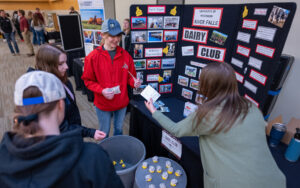Agriculture is closely interwoven in the history of both the University of Wisconsin-River Falls and the state of Wisconsin. The organizers of this year’s annual Ag Day on Campus hope to focus on farming’s future as well.
The event, which focuses on the important roles that agriculture plays in people’s lives, runs from 9:30 a.m. to 8 p.m. on Thursday, April 11. It will take place in the area in front of the University Center, E. 501 Wild Rose Ave., River Falls. In case of inclement weather, the event will be moved inside the University Center.
This year’s theme, “growing for generations,” symbolizes the longtime, pivotal role that agriculture has played in Wisconsin. It continues to have a significant impact even as farming undergoes changes, said student organizers Aleah Cole and Lashawna Vogel.
“It’s about the generational aspect of agriculture. That has been so important and has developed through the years, and agriculture really connects us all,” said Cole.
Ag Day on Campus was started at UW-River Falls in 2012 by the university’s Collegiate Farm Bureau chapter. The event will include a display of tractors along with Colleen the Dream, a large fiberglass Holstein cow.
Many booths staffed by agriculture industry workers and representatives of student agriculture clubs will be at Ag Day. Princess Kay of the Milky Way, UW-River Falls student Emma Kubal as well as the Wisconsin Fairest of the Fair, Kelsey Henderson will also be in attendance.
A favorite activity is attendees being able to view and pet farm animals.
“That is always a big draw,” Cole said. “People love to see and pet the animals.”
As part of the event, a panel of agriculture experts will discuss trends in modern agriculture and skills the industry is looking for in its employees. A free dinner featuring foods grown locally will be served at 5 p.m. in Room 200 of the Agricultural Science building on campus.
Food – specifically where food comes from – is a focus of the event. With so many people not living on farms, they often don’t make connections between food and farms, Vogel said.
“So many people are three generations removed from a farm,” she said. “They go to the grocery store to buy food, but they often don’t think about where their food really comes from and all that is necessary to get that food to the store.”


